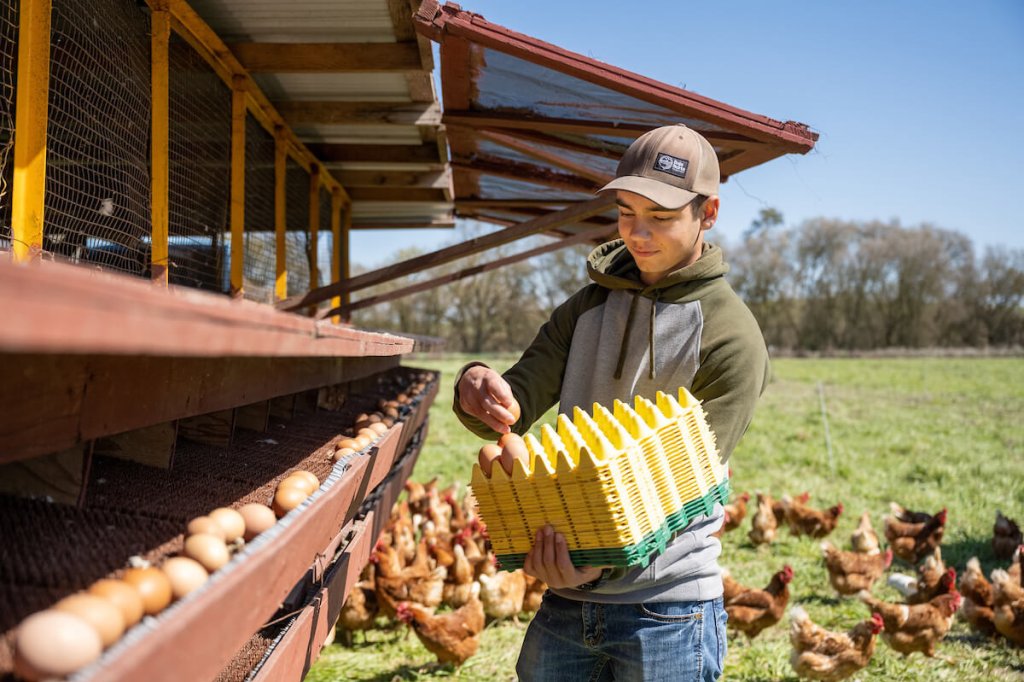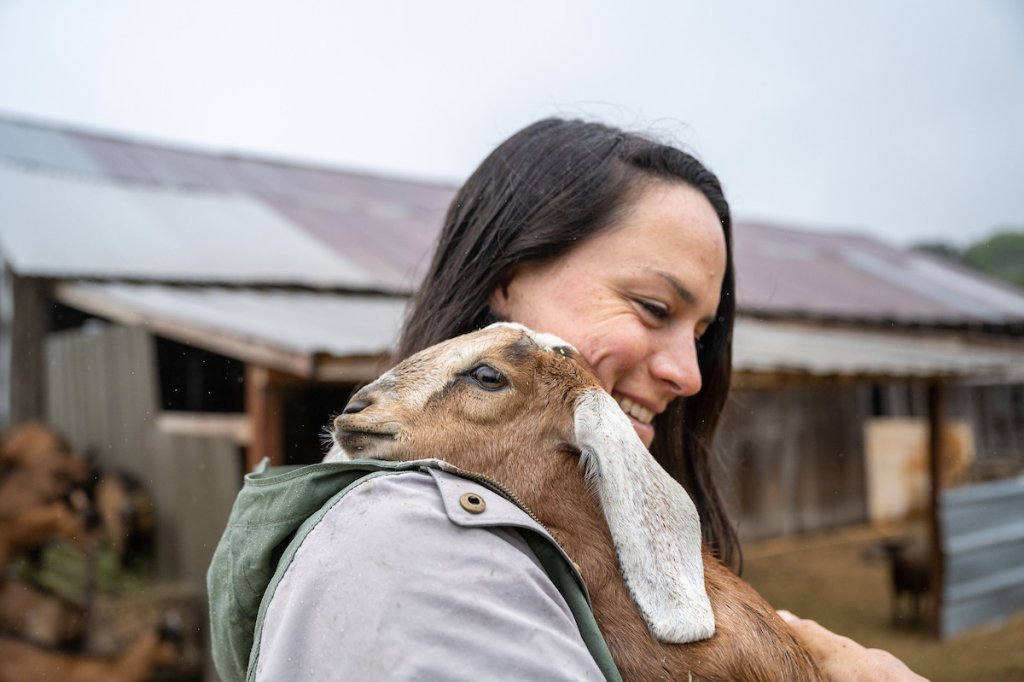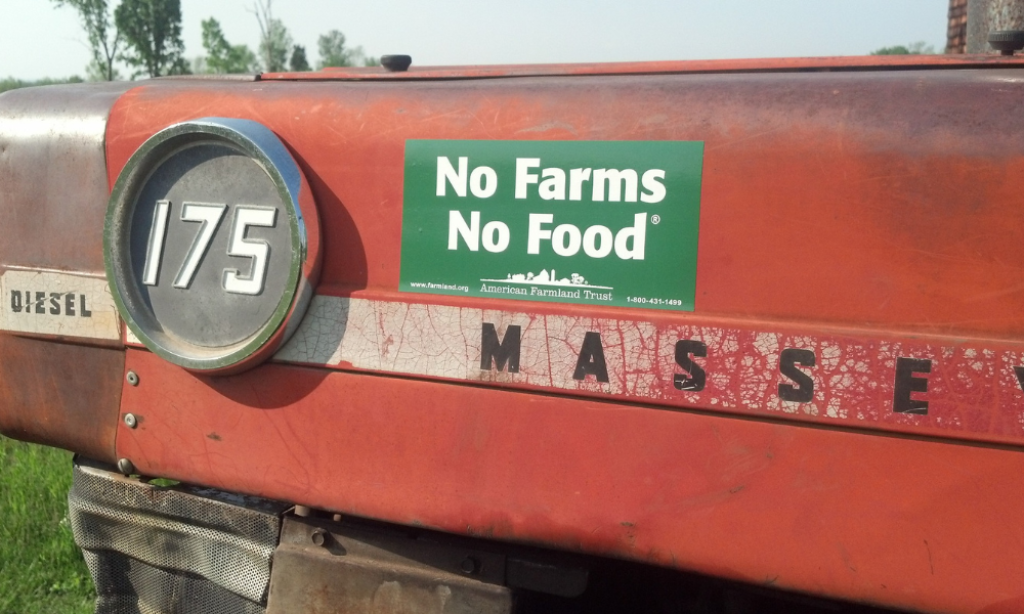American Farmland Trust Helps Protect San Joaquin Valley’s Lost Wagon Wheel Ranch
Left to right: Kole Upton, Jr., Kurtis Upton, Conner Peters, Kole Upton, Sr., Darin UptonSince the mid-1940s, the Uptons have operated Lost Wagon Wheel Ranch outside Chowchilla in California’s San Joaquin Valley, the nation’s leading agricultural region. AFT is helping protect the 1,099-acre family farm in perpetuity, and spur valuable conservation in rapidly growing Merced County, with the purchase of a conservation easement from the Upton family.
This easement is the first demonstration project of AFT’ San Joaquin Land and Water Strategy, which combines research, policy advocacy, agricultural land protection, and implementation of regenerative agricultural practices to address future impacts to the region’s farmland and dwindling water resources. Funding for this project was provided by an agricultural land mitigation agreement between the Department of Conservation and the California High-Speed Rail Authority, according to Kara Heckert, AFT California regional director.
“The Lost Wagon Ranch is exactly the type of productive, versatile, and resilient agricultural land that California wants to save,” explains Kara. “AFT salutes the family’s exceptional commitment to conserving the state’s rich agricultural resources for future generations. The farm is an admirable example of regenerative agricultural practices and wildlife conservation in a high–risk development area of San Joaquin Valley.”
For Kole Upton, co-owner of Lost Wagon Wheel Ranch, the chance to work with AFT on the easement allowed him to protect his family farm forever.
“You get tied to the land as farmers,” explains Kole. “My dad started the farm after World War II. My brothers are here. My sons are here. It’s a family thing. It’s a tradition in the San Joaquin Valley for these farms to be family operations. To me, society is stronger when you have an embedded farmer as part of the community. I’ve coached Little League here for 50 years.”
Three baby Swainson hawks in wetlands area built on the farm with help from USDA-NRCS.The Upton’s ranch is between Merced and Chowchilla; not far from Highway 99. It grows wheat, cotton, and almonds, as well as corn for Kraft Foods’ Corn Nuts. AFT determined this grower ranked highly in farmland quality, water reliability, groundwater recharge potential, and development risk. In fact, all soils on the ranch are classified Prime, Statewide Important, Unique, or Locally Important.
Protecting Precious Resources
A strong conservation ethic helps the ranch recharge groundwater and use farming practices beneficial for wildlife, soil health, and climate, including 25 years of composting.
“We’ve rotated our crops since we grew primarily cotton in the farm’s earlier days,” says Kole. “Now, we grow wheat one year, and then corn for Corn Nuts. In summer, wheat doesn’t need irrigation. So, if it’s a short water year, we’re able to farm our other crop.”
About a quarter of the land is permanent crops, such as almonds. “I like not having all permanent crops that require water annually,” he explains. “Under California’s Sustainable Groundwater Management Act, water is being allocated carefully because the underground aquifers are being depleted. By saving resources and growing diverse crops, I monitor my water better. In a bad water year, I wait to plant other crops to keep my permanent crops alive. Otherwise, I could lose a significant number of crops and probably won’t survive.”
“The Lost Wagon Ranch is exactly the type of productive, versatile, and resilient agricultural land that California wants to save.”
Lost Wagon Wheel Ranch uses six sumps, or recharge basins. With sprinklers on the permanent crops, the farm uses flood irrigation to recharge the underground aquifer as water goes through the soil. The soil is leveled so excess water goes into the sump, pumped back, and reused.
“In winter, when the flood flows in the river, our farm turns on the canal pumps, and puts water in the recharge basins,” says Kole. “This excess water recharges the groundwater, so it’s a win-win situation. The canals themselves will recharge 25 to 30 %, and if you have groundwater basins, it increases the effect. It’s like a reserve bank account. When surface water is available, we use as effectively as possible. We save groundwater supplies for droughts or times of less water.”
Harrier Raptor nest on the Upton’s farm.Along with a productive farming operation, the Upton family created a wildlife retreat that hasn’t been farmed in more than 40 years. This 16-acre area has two ponds, which along with other areas of the farm, attract Swainson’s Hawks, red-tailed hawks, owls, bobcats, Monarch butterflies, and foxes. In addition, a wetland restoration project with the USDA-NRCS helps the farm attract and protect the same species. They are also actively trying to attract tricolored blackbirds currently proposed for listing under the California Endangered Species Act to the wetland.
“We’re working to save the wildlife, because we have an obligation to keep things the way they were originally,” adds Kole. “It’s a family effort. My sister-in-law was a biology teacher. My daughter-in-law is a wildlife photographer. We do our own crop harvesting. So, if we see a harrier raptor out there nesting in the field, like this year, we wait until the fledgling harriers can leave safely before harvesting. We want them to survive and reproduce.”
As a young man, he asked his father once about a retirement plan for the family farm. “My father came back a week later with an envelope,” Kole says with a smile. “Inside was a plot for the local cemetery. His message was that a farmer doesn’t retire. It still makes me laugh.”
Learn how AFT is spearheading a five-year San Joaquin Valley Land and Water Conservation Collaborative to protect the region’s most productive, versatile, and resilient farmland and encourage regenerative agricultural practices.
Photos courtesy of Upton family




